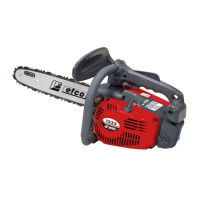
Do you have a question about the Efco 132S and is the answer not in the manual?
Detailed list and identification of all parts of the Efco 132S chainsaw.
Explanation of warning and caution symbols and their meanings for chainsaw operation.
Overview of legal requirements for chain saws, including muffler and spark arrester regulations.
Guidelines for using the chain saw specifically for tree service work, emphasizing trained operators.
Practices for safe operation of chain saws at height using ropes and harnesses.
Essential safety considerations and requirements for operators working at height.
Steps and checks before sending the saw up to an operator working in a tree.
Analysis of accidents and advice on safe one-handed use of the saw while working in a tree.
How to maintain a stable work position for safe two-handed chainsaw operation.
Specific instructions for safely starting the chainsaw when the operator is positioned in a tree.
Essential precautions for safe chainsaw operation, including personal protective equipment and general rules.
Safe procedures for handling gasoline and fuel mixtures, including storage and refueling.
Guidelines for safely operating the chainsaw, including proper grip, body positioning, and carrying.
Detailed explanation of kickback causes and how to avoid it, including types like rotational and pinch-kickback.
Strategies to minimize the risk of kickback through awareness and proper technique.
Techniques for maintaining firm grip, proper stance, and body positioning to control the saw.
Explanation of built-in features designed to reduce kickback hazards.
Description of the chain brake's function and importance for stopping chain rotation.
Information on guide bars and chains designed to reduce kickback risk.
Table listing recommended bar and chain combinations for the chainsaw model.
Advice on minimizing risks associated with prolonged exposure to vibrations.
Crucial warnings and precautions related to maintaining the chainsaw's safety and integrity.
Step-by-step instructions for attaching the guide bar and chain to the chainsaw.
Procedure for checking and adjusting the chain tension for safe and efficient operation.
Instructions for the initial break-in period of a new chain to ensure proper seating and tension.
Information about the bucking spike, its sharpness, and safety precautions when working near it.
Detailed instructions and warnings for safely fueling the chainsaw with the correct fuel mixture.
Specifications and ratios for mixing gasoline and 2-cycle engine oil for the chainsaw.
Steps for safely filling the fuel tank, including pre-fueling checks and post-fueling actions.
Explanation of the automatic oiler system and the importance of keeping the oil tank filled for lubrication.
Instructions on proper grip, stance, and safety equipment before starting to cut.
Step-by-step guide to performing basic cutting operations with the chainsaw.
Guidelines for maintaining a safe work area, including distance from bystanders and avoiding hazards.
Detailed steps for safely starting the chainsaw engine, including choke and brake engagement.
Instructions for the engine's break-in period to ensure optimal performance and longevity.
Procedures for starting the engine when it is difficult or flooded.
Steps to clear excess fuel from a flooded engine and restart.
Instructions on how to properly stop the chainsaw engine.
Important checks to perform before operating the chainsaw, focusing on chain movement at idle.
How to check and operate the chain brake to ensure its functionality.
Definition and basic instructions for bucking (cutting a fallen tree into logs).
Guidance on using a wedge to prevent the chain from being pinched during bucking.
Techniques for cutting logs that are under stress to avoid pinching the saw.
Introduction to different cutting methods used in chainsaw operations.
Explanation of the overbucking technique for cutting logs.
Explanation of the underbucking technique, including safety considerations.
Instructions for safely removing branches from a felled tree and pruning trees.
Detailed steps for safely limbing branches from a felled tree.
Techniques for pruning tree limbs to reduce weight and prevent bark stripping.
Identification and warnings about springpoles, which pose a significant danger during cutting.
A comprehensive chart outlining maintenance tasks and their recommended intervals.
Procedures for maintaining the chainsaw chain, including proper filing and raker clearance.
Detailed guide on how to sharpen the chainsaw cutters using the correct tools and angles.
Explanation of the correct top plate angle for filing chainsaw cutters.
Explanation of the correct side plate angle for filing chainsaw cutters.
How to check and adjust the depth gauge clearance for safe cutting.
Instructions for maintaining the guide bar, including cleaning, rotating, and lubrication.
Guidance on adjusting the carburetor, including warnings about factory settings and limits.
How to adjust the idle speed to ensure proper engine operation and chain stoppage.
Procedures for checking and replacing the fuel filter to ensure proper fuel flow.
Instructions for cleaning and replacing the air filter to maintain engine performance and prevent damage.
Instructions for cleaning and replacing the oil filter.
Advice on cleaning the starter unit and warnings about its spring.
Basic engine cleaning instructions and warnings about running the saw without parts.
Information on the correct spark plug type, gap, and replacement frequency.
Information about the spark arrester system and its maintenance for fire prevention.
Checks and maintenance for the chain brake, including brake band wear and lubrication.
A guide to identifying and resolving common problems with the chainsaw.
Guidelines for safely storing the chainsaw and fuel, including cleaning and ventilation.